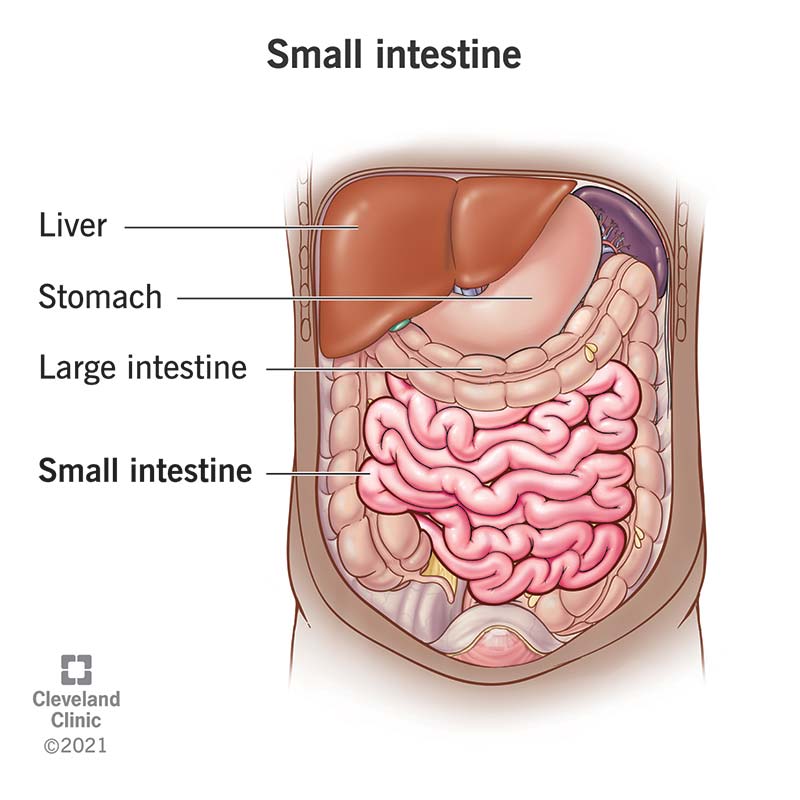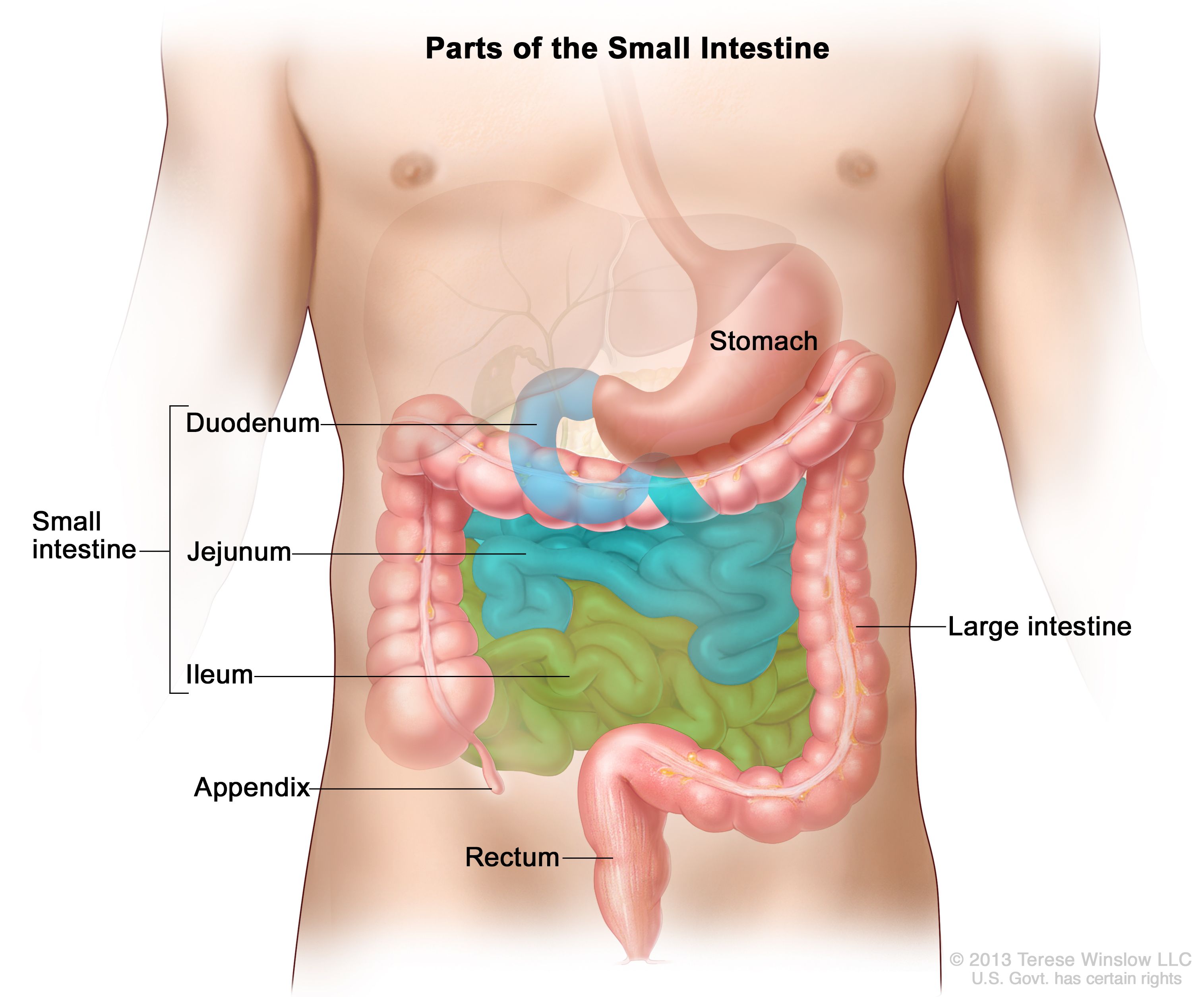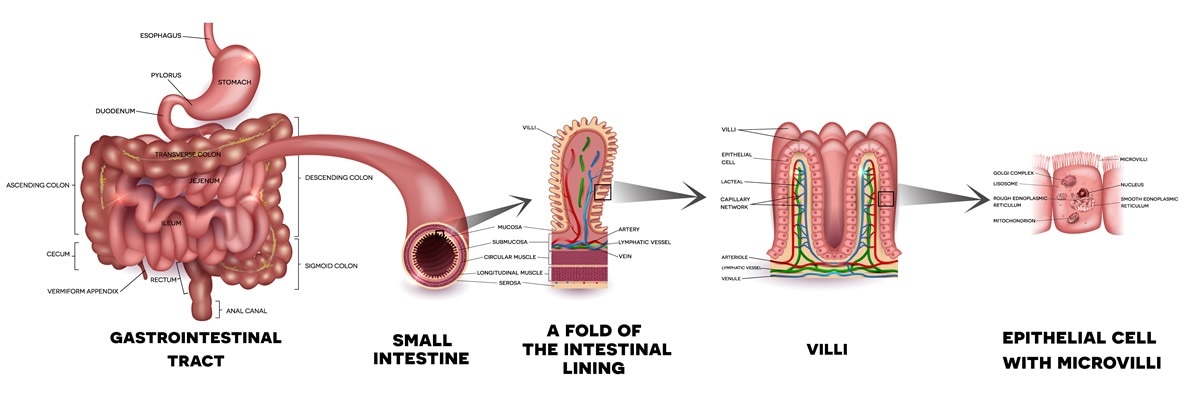Describe the Function of the Small Intestine
Asked Sep 25 2015 in Anatomy Physiology by BIsisE. Functions of the small intestine.

Small Intestine Function Anatomy Definition
What are the functions of the small intestine and the large intestine.

. What will be an ideal response. The small intestine is the part of the intestines where 90 of the digestion and absorption of food occurs the other 10 taking place in the stomach and large intestine. Describe the divisions of the small intestine and their respective functions duodenum 25cm - gastric acid neutralisation digestion iron absorption jejunum 25m - 95 of nutrient absorption.
However studies of its biology are limited by the lack of a feasible method to visualize all the relevant compone. Together with the esophagus large intestine and the stomach it forms the gastrointestinal tract. Functionally the small intestine is chiefly involved in the digestion and absorption of nutrients.
Absorbs products of digestion chemical digestion absorption of proteins lipids and carbohydrates. These two activities are facilitated by structural adaptations that increase the mucosal surface area by 600-fold including circular folds villi and microvilli. Structure of small intestine.
Most of the digestive enzymes in the small intestine are secreted by the pancreas and enter the small intestine via the pancreatic duct. Secretion from Lieberkuhns Crypts takes place from two different cellular subtypes. It receives pancreatic secretions and bile through the hepatopancreatic duct which aid with its functions.
The main function of the small intestine is absorption of nutrients and minerals from food. Dysfunction of the small intestine can bring you some uneasy experiences such as diarrhea while travelling or worse on a date. Describe the structural characteristics of the small intestine that enhance its function as the major absorber of nutrients.
In the small intestine partially digested food which has been reduced to a slurry called chyme is mixed with intestinal juices. The small intestine is part of the digestive system and is mainly responsible for the absorption of nutrients. The liver secretes the bile juice which converts fat into tiny droplets so that their digestion becomes easy.
The partially digested food is absorbed by the duodenum of the small intestine along with the digestive juices from the liver pancreas and its own. The main function of the small intestine is absorption of nutrients and minerals from food. The small intestine is where digestion is completed and virtually all absorption occurs.
The three main regions of the small intestine are the duodenum the jejunum and the ileum. The term small intestine refers not to its length but to its diameterabout 25 cm 1 in. The lacteal is a blunt-ended lymphatic capillary located at the center of a villus in the small intestine that plays multifaceted roles under both physiologic and pathologic conditions.
Learn about the structure of. The small intestine absorbs water and nutrients and it prepares the food for the next step in digestion the large intestine. Answered Sep 25 2015 by.
The small intestine is where most digestion takes place. Complete Digestion of Food. The main functions of the small intestine are to complete digestion of food and to absorb nutrients.
How do the different parts of the small intestine work. The small intestine carries out most of the digestive process absorbing almost all of the nutrients you get from foods into your bloodstream. Brunners Glands and Crypts of Lieberkuhn.
Longest part of the GI tract first part duodenum second part jejunum third part ileum Functions of small intestine. The three major classes of nutrients that undergo digestion are proteins lipids fats and carbohydrates. The small intestine is the longest part of the alimentary canal and it begins at the pyloric sphincter of the stomach coils through the central and inferior part of the abdominal cavity and eventually opens into the large intestine.
Secretions of the small intestine occur from two types of histological structures. In living humans the small. The tissues the layers are composed of are The serosa i View the full answer.
Because it is so long it must twist and turn through the abdomen. The walls of the small intestine make digestive juices or enzymes that work together with enzymes from the liver and pancreas to do this. Most vitamins and minerals as well as fats and some water are absorbed in the small intestine.
Small intestine- secretion of mucus secretion of enzymes and absorption of digested. The small intestine is made up of the duodenum jejunum and ileum. Digestion involves two distinct parts.
The small intestine is a 20-foot-long tube that is part of the digestive tract and connects the stomach and the large intestine. The small intestine is involved in the digestion of food and absorption of nutrients. The small intestine is where most chemical digestion in the human body takes place.
Brunners Glands mostly secrete mucus which is designed to protect the small intestine mucosa from damage by stomach acid. After chemical digestion in the duodenum food moves into the jejunum where the muscle work of digestion picks. The primary function of the small intestine is to continue the process of digestion that began in the mouth and the stomach.
This article will discuss the anatomy function and neurovasculature supply of the small intestines. In this article we will discuss the histology structure and secretions of the small intestine. To help break food down the small intestine receives digestive juices from other organs in your digestive.
The small intestine has four tissue layers The serosa The muscularis The submucosa The mucosa 3.

What Is The Function Of A Small Intestine Brainly In

Definition Of Small Intestine Nci Dictionary Of Cancer Terms National Cancer Institute

Comments
Post a Comment